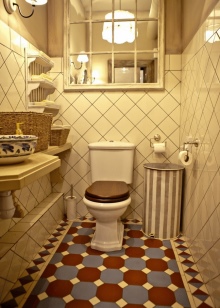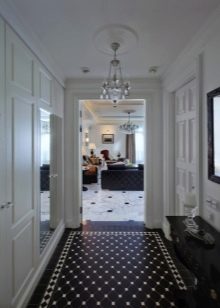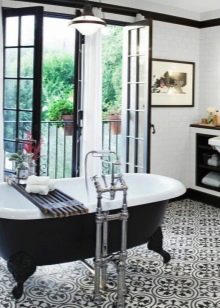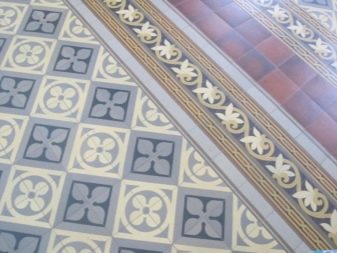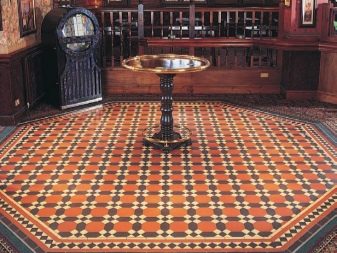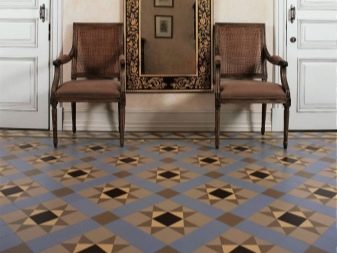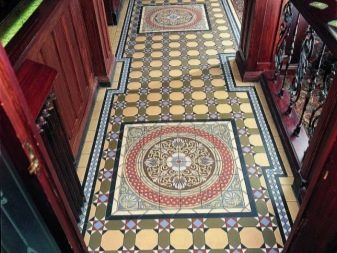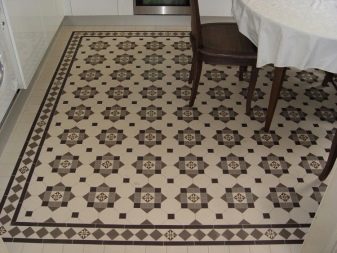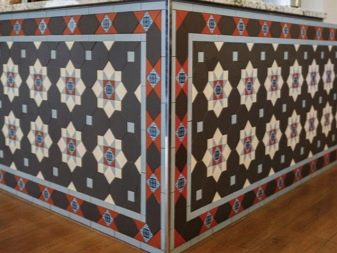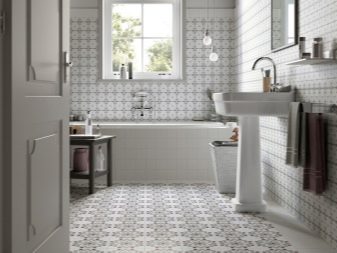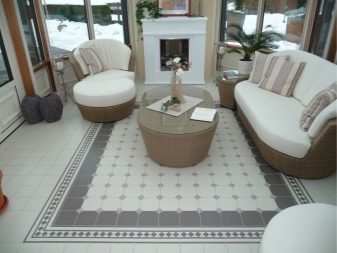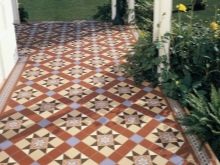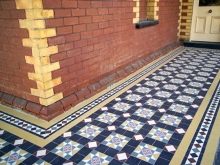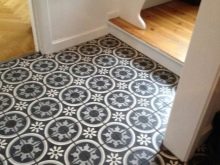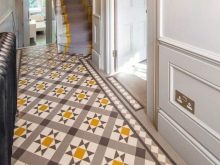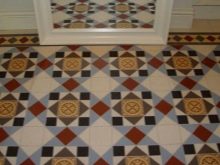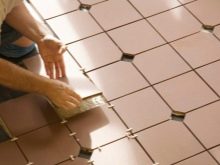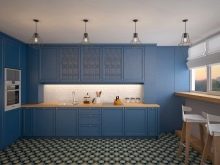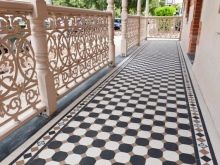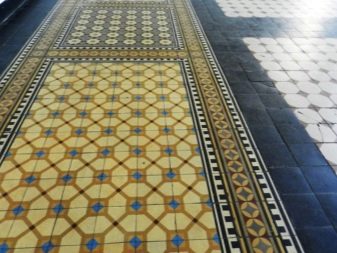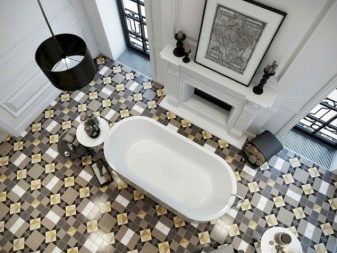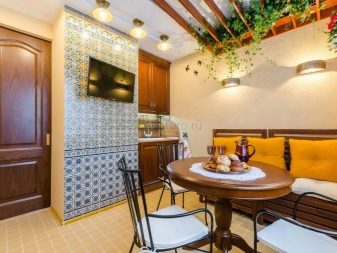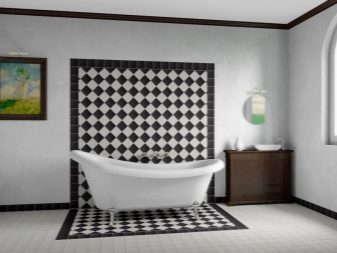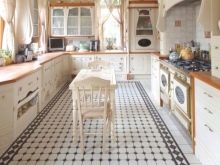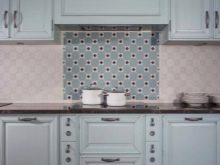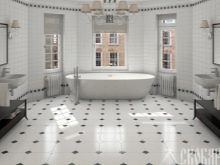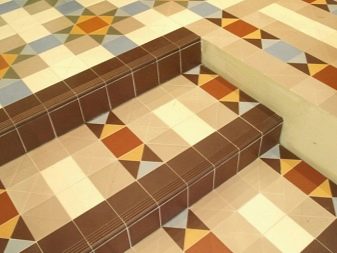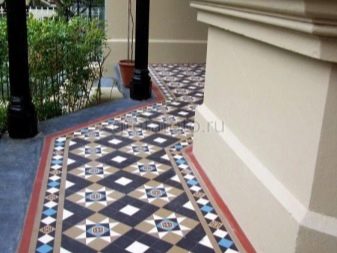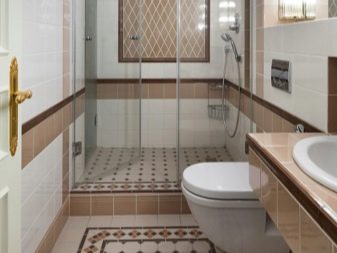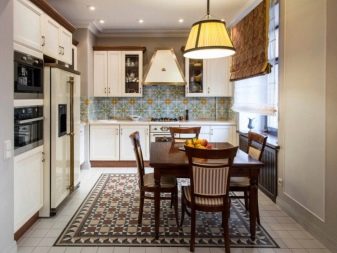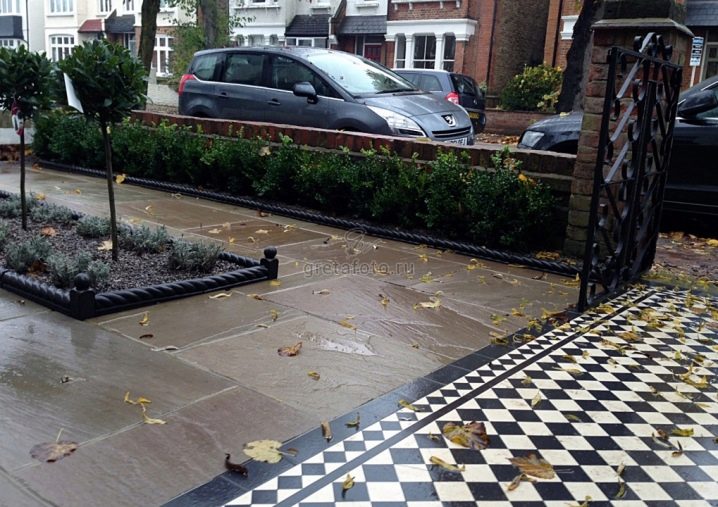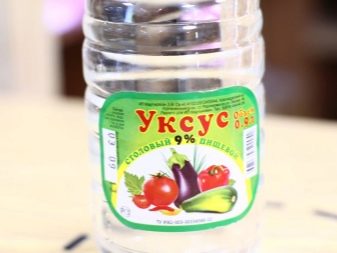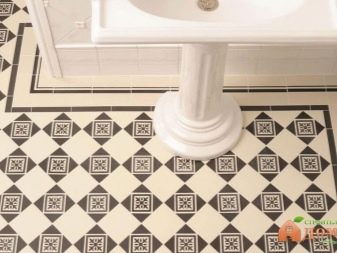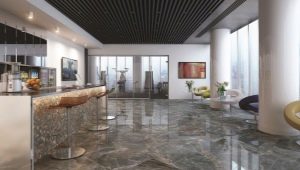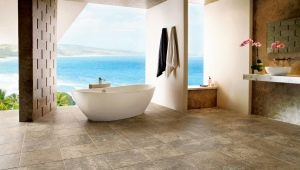Metlakhskaya tile: application in interior design
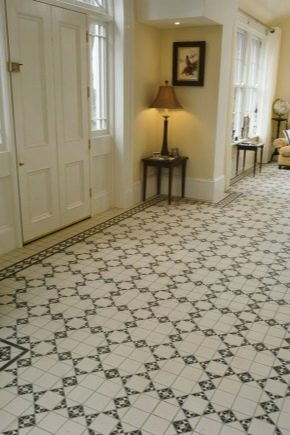
Among the huge variety of tile materials, a special place is occupied by slab tiles. If you are looking for a unique floor or wall covering that can decorate almost any style in the interior, metakhskaya tile or its imitation is exactly what you need.
History of creation
Metlach ceramic tile was named after the German city Mettlach, where in the XIX century they began to produce this finishing material. At first, the ceramics manufacturer was called Villeroy & Boch, when 2 of these surnames, having opened a family business, formed a partnership with the board in Metlach. Metlahskaya tile quickly became a household name due to the original design and unique strength.
Especially popular tile used in the Victorian era, no wonder it was then called the "Victorian tile" and covered it floors of cathedrals, public spaces and private residences. Coatings from Mettlach were brought in with the construction of the famous "Titanic", and are still present in the decoration of many architectural monuments.
In the late 19th and early 20th centuries, the Villeroy & Boch trademark became a ceramics supplier for the Russian imperial court.
This finishing material was especially actively used in St. Petersburg, where at the beginning of the 20th century there was even a specialized shop of this German company on Nevsky Prospect. Visual confirmation of the technical properties of this tile are the ancient interiors of the historical buildings of the northern capital - the decoration of St. Petersburg palaces often used this finishing material, which adorned not only the interior, but also the picturesque parade.
In our country, the peak of popularity of ceramics ceramics fell in the second half of the twentieth century, when it was used in the construction of multi-storey residential buildings and lining socles.
At present, metal tiles are produced in several countries at once (most of the factories are located in France and Portugal), including Russian-made tiles (EvroKeramika plant).
The French factory Winckelmans is one of the oldest, which still functions today. It is here that preserved ancient technology. By adding to them modern design ideas, the company's specialists create a unique “piece” product, which has characteristics such as reliability, impeccable quality, natural texture, maximum natural shades and patterns, as well as a pleasant matte sheen.
Special features
The main material for the manufacture of Metlakh tile is refractory clay. The plants are located, as a rule, in the places of clay extraction, in Russia it is the Dmitrovsky pit. Brooms - the hardest tile compared to other. Even after a fall or impact, there will be no scratches or chips on it, because such material is able to withstand pressure from 3200 to 5550 kg.
In fact, the Metlakh tile is endowed with all the properties of natural stone - it withstands heat and cold, and is also absolutely acid-resistant.
The peculiarity of such a tile is the use of a unique decorative reception “brooms”, when a tile is first painted with natural pigment, and only then it is sent to the kiln to be burned at a temperature of about 1100-1200 ° C. As a result, a strong tile of natural shade is obtained. It is thanks to the burning and pressing that the ceramic coating acquires high performance characteristics, it is not inferior in strength even to porcelain stoneware.
Such a monolithic and durable coating is used not only in apartments, but also for finishing facades, terraces or paths in front of the house.
Sizes and shapes
The slab tiles are usually small in size about 10x10 cm, although there are various shapes and shapes. Sizes can vary from 3.5 to 20 cm. At the same time the form of tile can be completely different - it is squares, rectangles, crosses, triangles, octagons. There are also additional decorative elements for the decoration of the floor and walls.
Most often, tiles of different sizes are used within one composition. First, the pattern is laid out from large tiles, and then from small ones. Since the thickness of the tiles is different, when laying, make sure that the ceramic surface is on the same level.
And be sure to make a drawing on the surface: in order not to be mistaken during the installation, you need special marking.
Advantages of ceramics ceramics
There are plenty of features and advantages of ceramics ceramics over other finishing materials:
- Versatility (tile is used both in the interior decoration of the floor and walls in the house, and for terraces and paths in front of the house, as well as public buildings).
- Original design (many forms and ornaments will help to create a unique pattern "not like everyone else").
- Natural composition from high-strength clay, and also its environmental friendliness.
- Hardness and strength (it is very difficult to damage brooms, and even if you drive a tile on a car, it will not crack).
- Durability (the service life can be not only decades, but also centuries, which has been proven in practice), and the color does not fade with time. This is achieved by soaking the tile with pigments, when after firing the product becomes even more monolithic.
- Wear resistance (resistance to humidity and temperature changes, therefore, suitable for outdoor decoration, whether on the street heat, snow, wind or rain).
- Chemical Protection cleaners, acids and alkalis.
Of the minuses, we note only the complexity of the installation, the problems in cutting and the fact that it will be very difficult to create a competent drawing on your own without a professional designer.
Design features. Variants of use in the interior
Of course, not everybody will “understand” the Metlach tile. This should be a person with artistic thinking, because you need to have a mature taste to choose an interior with a complex ornament. The use of such ceramics is permissible in both modern and vintage interiors. The ethnic and oriental themes are perfectly combined with such tiles.
Metlahskaya tile will help to create a decorative accent in the room - for example, to make a solid floor and decorate it with elegant skirtings.
This coating is suitable for decorating the bathroom, as it does not slip and does not absorb moisture. Also from the broomstick you can lay out a luxurious carpet for the living room or a spacious kitchen. A rather unusual, but decorative, broomstick panel on the wall will be a spectacular device.
Also small-sized metlahskaya tile perfectly fit into the interior of the kitchen of any design - with the help of such ceramics you can make a kitchen apron or work surface.
The broomstick is also suitable for the decoration of the terraces in front of the house, as neither snow, nor rain, nor frost are afraid of him.. And with the help of rounded elements, you can effectively arrange the steps on the stairs. A great idea would be to tile such a fireplace with a tile, as well as a platform in front of it. You can even decorate ordinary doors around the perimeter with a tile of brooms in the form of a mosaic.
Agree, such a finishing material is truly a find for the designer. Metlahskaya tile can be used literally everywhere.
Choice of color and size of metal tiles
In the modern collections of Metlakh tile there is a huge variety of shades and ornaments. It’s not so easy to stop at something without the help of a professional designer.
Therefore, use the following helpful tips:
- For lining the tracks fit a larger tile non-marking shades.
- To decorate the room from the inside, use tiles of medium size, beige and pastel shades. This will visually enlarge the room and add space.
- When choosing tiles, consider the lighting in the room, because artificial light sources can change the shade of the coating. For example, under a yellow lamp, a blue tile will appear greenish.
- To emphasize the ornament of the floor tiles on the floor, lay a homogeneous tile without a pattern around the perimeter of the floor covering, which will give an interesting accent to the interior.
Features care for the tile
Caring for the tile is very simple - you will need any cleaning agent, water and a rag. At the same time, even aggressive household chemicals are not capable of harming such a durable coating. To give the tile extra radiance and shine, you can rub it with paraffin or wax, having previously heated it in a water bath and dipped a cork in it, with which you will clean your ceramic “carpet”.
And even easier to clean the surface with a solution of water and vinegar (a glass of vinegar in a bucket of water). It is unlikely that you will even have to repair or restore such a coating, because the manufacturers guarantee that the porcelain tile is able to serve faithfully for several decades.
The main thing is to competently draw up a design project and properly lay down the coating, for which purpose do not neglect the help of professionals.
By the way, some designers dare to combine such antique tiles with modern finishing materials similar in texture and properties - for example, clinker or porcelain stoneware. The combination of the legacies of different eras with the pointed eye of a professional designer and the skillful hands of a master leads to unexpectedly successful results.
For how to properly lay the tiles, see the following video.
